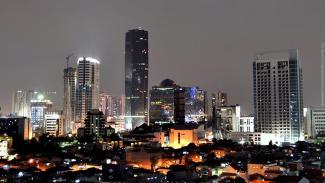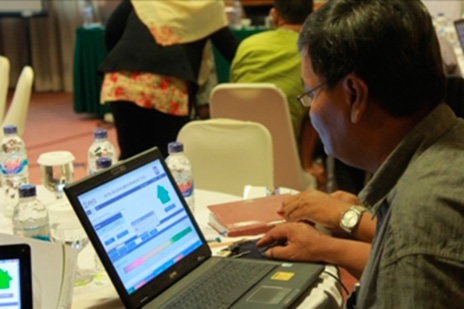A Regional Approach to Benchmarking
More than half of the world’s new buildings are constructed in Asia every year, and the buildings sector accounts for a quarter of Asia’s final energy consumption. The benchmarking project started in Indonesia and demonstrated the potential for improving energy performance across the region.
Disclaimer: This example is provided for general instructive purposes only and does not represent the work of USAID. The inclusion of this example, its funding agencies and implementing partners does not constitute support or endorsement of any specific ideas, concepts or organizations by the United States Agency for International Development or the United States Government.
Problem
More than 50 percent of the world’s new buildings are constructed in Asia every year, and the building sector accounts for approximately 25 percent of Asia’s overall energy consumption. Energy use in existing buildings is the largest component of that energy consumption but has largely been overlooked as a major source of energy and greenhouse gas (GHG) emission reductions. In Indonesia, buildings account for 20 percent of energy consumption.
Solution
Experts estimate that if building energy performance benchmarking tools for hotels, commercial offices, retail buildings and hospitals were available in Indonesia, the Philippines, Vietnam and Thailand, they could facilitate savings of 540 million gigajoules of energy and avoided emissions of 7.9 MMtCO2e (equal to 202 million new trees planted) across Southeast Asia over five years. Benchmarking is a strategy for improving building performance and provides a common metric to allow buildings in the market to practically and cost-effectively assess their energy efficiency (EE) relative to similar building. This data can support decision-making on EE improvements.
This project explored a regional solution to reduce energy use and carbon emissions in the large and continuously expanding stock of commercial buildings in Asia through the development and demonstration of a regional building energy performance benchmarking system and engagement of key regional partners. USAID’s Energy Efficiency for Clean Development Program, implemented by ICF, created practical tools and activities to help drive action on reducing energy use in the building sector across the region.
Starting in Indonesia
The benchmarking system was first developed for the Indonesian hotel sector, where existing energy consumption data created an opportunity to develop and showcase the potential impact for benchmarking across the region. Indonesian hotels were experiencing steady growth with a 9-13 percent increase in visitors annually. Benchmarking and EE improvements at 1,000 hotels in Indonesia were estimated to yield annual savings of 533 million kilowatt hours (kWh), 388 billion Indonesian Rupiah (US$ 38 million) and 381,000 MtCO2e avoided (equivalent to 105 installed wind turbines).
Scaling Benchmarking in the Indonesian Hospitality Sector
The Benchmarking Tool which was developed for Indonesia was designed to be simple to use while providing an accurate comparison of building energy performance. A minimum set of variables, including 12 months of energy consumption data and attribute data (such as climate, weekly operating hours, and occupancy) are all that is required to generate a benchmark score for a building.
As a result of the successful launch of the benchmarking tool through energy management trainings and hotel audits, the Indonesian Ministry of Energy and Mineral Resources became interested in using the tool to set minimum energy performance standards for the hospitality sector. The Indonesia Ministry of Tourism announced that it would include the energy benchmark score as a criterion for Indonesia’s Green Hotel Award, a prestigious annual award given to hotels that have shown commitment to and achievement in environmental stewardship.
Innovation
A building energy performance benchmarking tool is an innovative mechanism for improving the energy performance of an existing stock of buildings. Its strength lies in providing a practical and equitable assessment of building performance in order to identify energy and financial savings opportunities and make the business case for EE investments. When used across a portfolio, it provides a good indication of which buildings should be targeted for audits or retrofits (due to underperformance). It is also valuable in measuring progress resulting from improvement projects as well as identifying buildings that could achieve green building certification.
A benchmarking tool also provides a platform for national and regional building EE programs, such as the U.S. Environmental Protection Agency (EPA) ENERGY STAR® program. Such programs enable tens of thousands buildings to initiate energy performance improvements and contribute substantially to higher levels of efficiency and reductions in the carbon intensity of buildings. Over the past twenty years, the ENERGY STAR program has contributed to emissions reductions of 784.9 MMtCO2e from buildings.
Creating Access to Data
Access to high quality data is critical in enabling policymakers and other technical institutions to develop accurate building energy performance benchmarking tools. Often, data is not collected through any systematic method, or in some cases, where such collection does occur, data is not made freely available. A key achievement of the performance benchmarking project was to develop Indonesia’s first publicly available, national hotel energy performance database, including all data points required to develop a national hotel energy performance benchmarking tool.
Providing a Comprehensive Solution
While a building benchmarking tool is an effective way to evaluate actual metered energy use, indicating the level of energy performance and comparing buildings to a national population, it cannot, by itself, explain why a building is performing well or poorly and how to improve energy performance. To address this gap, the team developed and provided a suite of training modules and technical resources to train building energy managers in improving their hotel energy performance after benchmarking.
Challenges
The Excel-based benchmarking tool was made available to Indonesia’s Ministry of Energy and Mineral Resources (MEMR), the national agency that administers and organizes the energy sector, and the Ministry of Tourism. Extensive discussions were held with MEMR at the close of the program about specific requirements for owning and maintaining an on-line building energy performance benchmarking tool. This included information on what is required to develop a benchmarking tool, host the benchmarking tool on a national website, maintain and update the national energy performance database and benchmarking tool, resolve intellectual property issues and cover future costs associated with maintaining and expanding an on-line operational benchmarking tool.
MEMR realized the value of the energy performance benchmarking tool but did not commit further resources into expanding and maintaining the existing benchmarking tool or housing it online.
Lessons Learned
This project demonstrated the impact of no-cost/low-cost energy savings measures, which counters the assumption that investment and financing is key to reductions in energy demand or improvements in buildings. Significant savings can be unlocked through changes to equipment scheduling or set-points . Not only can these types of measures be easily implemented, they can immediately produce cost savings which can make the case for additional improvements that require companies to invest in technology. Six hotels received Opportunity Assessments which included interviews and analysis, with a report that provided no-cost/low-cost recommendations and included detailed implementation instructions for engineering and management staff. Local engineers also participated in these site visits and received training, which they later used to conduct an additional 24 hotel EE assessments under USAID’s ICED program.
Spotlight: Demonstrating Proof of Concept
The project produced an Indonesia Hotel Energy Management Manual with guidance on using the benchmarking tool and improving energy performance. A number of additional resources were developed including case studies, technology snapshots, a chiller retrofit financial analysis tool, and a lighting cost-benefit analysis tool. Below are more details on three additional resources:
A training module, “Hotel Strategic Energy Management No/Low-Cost Approaches to Improve Energy Performance,” was designed with stepwise guidance on implementing more than 30 operational and technical measures to improve lighting, heating, ventilation and air conditioning (HVAC) equipment, etc.
An Excel-based Opportunity Assessment Tool was developed to generate a report of recommended measures based on responses to a series of questions about a building’s current conditions.
A Hotel Energy Management Checklist assists hotel managers and engineers to implement monthly, weekly and daily energy performance improvement measures at hotels.


